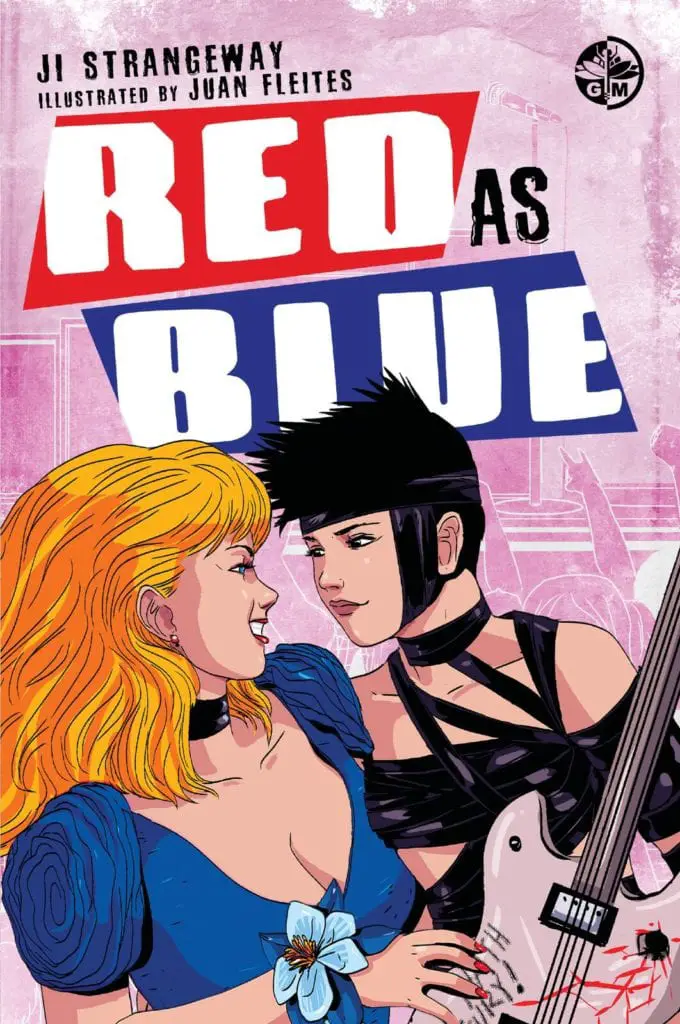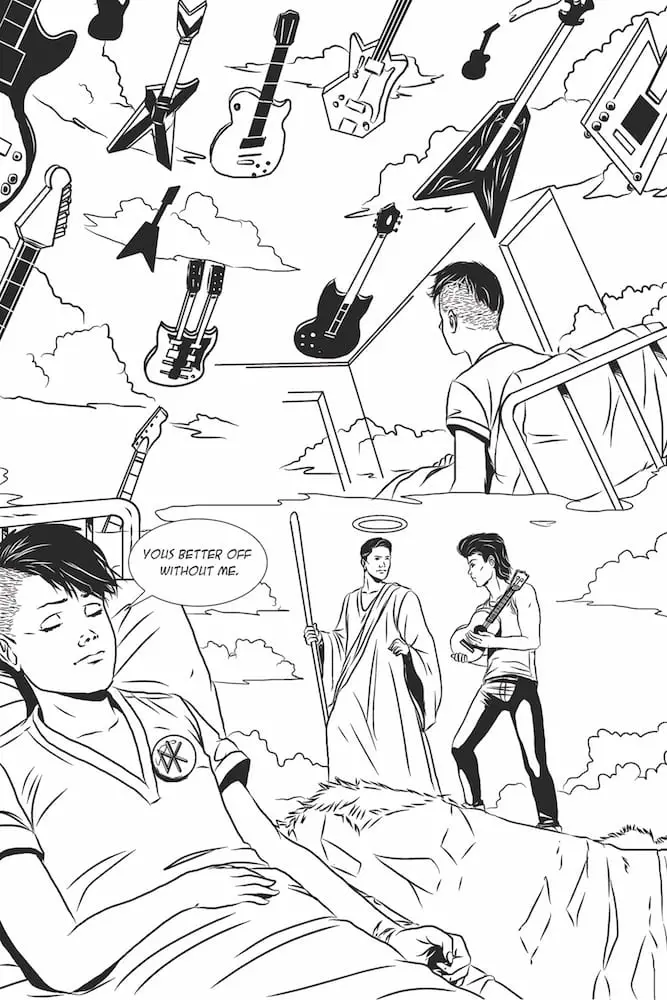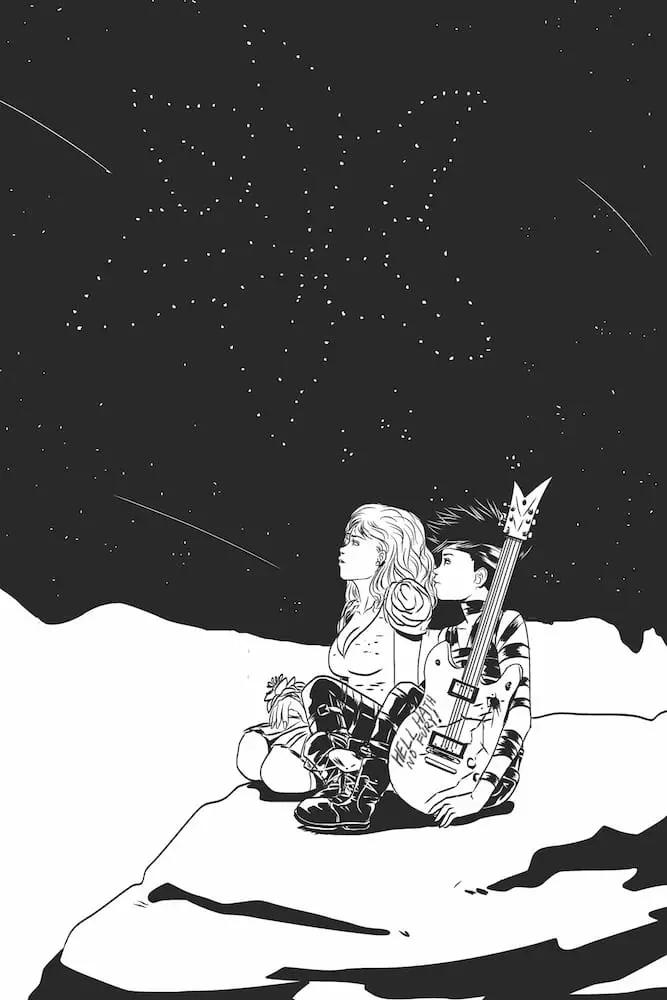A few weeks back, I was given the joy of interviewing Ji Strangeway, author of the hybrid novel Red as Blue, for my Creator Corner series. As of today, the novel is available for pre-order and I’m here to give you reasons why you should pre-order the hell out of it.
Red as Blue is a queer, female-centric coming of age story set in the narrow minded, repressive environment of the 80s. A time when, if you didn’t fit in, you might as well not exist. But out of this rigid mentality came some of the most iconic musical genres to define my and subsequent generations: grunge, punk, alt rock. Red as Blue intertwines these two coming of age stories—that of the characters and music—in a vivid, dreamy story full of catharsis and healing even as it tackles tough subjects like self-harm, school shootings, and the ways that people mess each other up. This is one you don’t want to miss.
A Brief (Spoiler Free) Rundown
 15-year-old June Lusparian is an outcast caught between worlds. Half Mexican and Half Armenian, June hovers on the border of adulthood, searching the streets of Paradise and the halls of Paradise High for signs of redemption—symptoms of life. She longs to carve open her own space to find a beating heart in a barren world. Only her secret gift for music offers a hint of hope. When she falls for blonde, cool girl Beverly, captain of the Spirit Girls cheer squad, June hopes she may at last have found that one true thing.
15-year-old June Lusparian is an outcast caught between worlds. Half Mexican and Half Armenian, June hovers on the border of adulthood, searching the streets of Paradise and the halls of Paradise High for signs of redemption—symptoms of life. She longs to carve open her own space to find a beating heart in a barren world. Only her secret gift for music offers a hint of hope. When she falls for blonde, cool girl Beverly, captain of the Spirit Girls cheer squad, June hopes she may at last have found that one true thing.
But as their nascent romance grows, June learns true connection requires more than a bond of pain and the ache of desire. Paradise is more than an idea, more than a town. And forgiveness never falls from heaven of its own accord.
The Good Stuff
As Strangeway and I discussed when I interviewed her, this is a hybrid novel combining elements from prose, screenplay, and graphic novel. Just based on her description of her process, I was fascinated; actually reading it didn’t just meet but exceeded my expectations.
The novel offers very little setting description unless it is pertinent to the story, yet I never had trouble imagining that for myself. I’m a very visual person, so the shorthand (@June’s House #bathroom, for example) worked as it was designed to in quickly dropping me into the location with minimal set up. For a setting that’s familiar to most audiences—high schools, parking lots, underground music scenes—it works impeccably. The graphic novel panels interspersed throughout slowed down the action and created space to immerse yourself in key moments of the story.
The choice to utilize screenplay format for dialogue works equally well. Rather than relying on adverbs or adjectives to describe how characters speak, Strangeway leaves that open to interpretation. Yet, as with a screenplay, there’s not a lot of ambiguity involved. You can tell what the characters think and feel based on what they say. It’s a unique reading experience and one that felt more immersive than most novels because of my role as reader filling in the gaps. I felt, as I believe Strangeway intended, as if I were as much a participant in the creation of the story’s meaning as she was.
The other benefit to these choices is greater space to explore character’s interiority and how that influences their perceptions of themselves and the world. Strangeway trims the fat where necessary, but that doesn’t mean she isn’t willing to indulge in other areas. This isn’t so much a bone-thin story as it is one that knows what it’s about and where it wants to spend its time: the space within and between characters.
And when Strangeway does offer description, it’s bursting with vivid detail. Her prose is dreamy, flowing, and highly evocative. She manages the difficult feat of being both specific and multilayered. There were moments I reread a paragraph multiple times and each time, I got something new out of it even if the overall impression remained the same.
The lyrical prose tells us as much about the characters themselves as it does about the world they maneuver. Just take this excerpt describing Beverly’s first impression of June:
June’s head hangs like bruised clouds. So low that the sun could set behind her ears. Nothing exists in the parched, crusted earth except June and Dark Fog, her shadow.
Beverly steps into the dry, red world.
Infernal sparks quickly creep up her ankles. Her white Adidas melt at the edges, warping the thin blue stripe to tremor in waves. She parts her lips in shock at June wearing the Grim Reaper’s cloak in Hell’s oven. June lifts here eyes to the Why Dost Thou Forsaketh sky and screams…
Pained cries pierce Beverly’s heart. Always glass half full, she now sees the mystery of half empty…This girl’s got nothing going for her. But there’s gotta be more!
It borders on magical realism, and it’s breathtaking to read.

The distinct writing style and format creates some of the most compelling and interesting characters. There’s a unique level of interiority to each of them that on its own is something I’ve only rarely seen in all my years of reading. Plus, despite utilizing the same style for all, each of the characters has a distinct inner voice and perspective. I feel like I know them and by the end of the novel could tell them apart even sans naming or context. June’s perceptions differ as much from Beverly’s as they each do from Kimberly’s. Strangeway shows rather than tells, just how much these characters have going on below the surface.
On a more personal level, Red as Blue resonated with me in multiple ways. June’s experience as an outsider, not fitting in, and being teased struck a chord with me. While I, thankfully, did not have to experience the kind of racism she does, I grew up on the fringes even of my conservative Christian environment and never quite felt like I belonged anywhere, much like June. Like June, I also grew up with a lot of self-hate, and Christian culture was often weaponized against me in the covert ways that Kimberly uses it against June. From the outside, all was joy and peace and “being like Jesus.” Behind the scenes, it was both the creation of wounds and salt on ones I already had.
Similarly, as someone raised in the kind of environment and culture Beverly was and in roughly the same time period, aspects of her story hit home to me as well. I wasn’t a cheer captain or popular, but I did go to Bible studies like the ones Kimberly invited her to, and, like her and Kimberly, believed that my attraction to women didn’t make me ‘gay’ because I had no framework within which to understand my desire other than a ‘straight’ one.
I appreciate that Red as Blue isn’t so much a coming out story as a recognition story. Rather than focus on June’s and Beverly’s experiences of attraction vis-à-vis their parents or society, it’s simply about their feelings for each other. Their story focuses on their own experience of how they feel rather than them learning how to talk to others about it. It isn’t a better story than the typical coming out story, just a different one, and one that receives less focus. Although the characters are younger than me, the focus on their recognition of their feelings resonated with me more strongly because of how similar it has been to my experience of my own queerness.
The 80s context adds an even deeper layer of engagement both in the religious conservatism and rigid in group/out group dynamics and in the power of music. This is my childhood and young adulthood. Reading a story about young queer women in this specific time period falling in love speaks much more powerfully to me than modern-day ones because the setting is one I lived in. This could have been me if I had the language to understand myself, and less social and religious constraint. It’s like getting to see an AU version of what my life could have been—both the traumas and joys of being queer in this time.
Yet even if this isn’t a setting in which you were raised, there’s a lot to get out of it. The 80s directly informed where we are now—the major fault lines and religio-cultural divides. Gen X came of age in the 80s and the Boomers, those now the self-perceived cultural ‘keepers’ of our society and the most powerful in our government, were their parents. We now live in the world shaped by the parents and kids of the 80s.
As such, I think teens now would recognize a lot of eerily similar situations and mindsets. We’re still seeing adults both talking over and victim blaming the children who survive school shootings. The one major difference now is that this current generation doesn’t have the same suppressive norms to prevent them from making their voices heard. In showing the world as it was then, Red as Blue reinforces the importance of speaking your truth, telling your story, and not letting anyone tell you who or what you have to love. All values that kids these days have been gifted with in a way that those of us born and raised in the 80s had to fight for.
In its own unique way, Red as Blue is an ode to what students like Emma Gonzalez speak out for. It’s also a catharsis, but in a healing way and one that opens the readers up to new perspectives. In conversation with me, Ji Strangeway called it ‘sacred,’ and that’s a great word to describe this book. When I turned the last page, a deep sense of validation, cleansing, and passion settled on me. I’d faced the worst of what my childhood environment wrought, found something beautiful in it, and now had a greater desire to see change in the world.
It sticks with you. I’m still thinking about it weeks later. It’s a story I didn’t know I needed, and now that I’ve experienced it, I want everyone to share in it with me.
Potential Drawbacks
While I loved the unique style and format, some might find it not to their taste. For those who are less visual, it might be difficult to visualize the evocative prose in the way it’s intended. It’s not a book you can sit down and read in an afternoon, or if you can, I don’t recommend it. It’s a book that rewards taking your time and really immersing yourself in it. None of these things are drawbacks for me personally, but it’s a different enough story that it might take getting used to.
The only other thing to mention isn’t so much a drawback either as a warning. Red as Blue moves through some pretty tough topics. It does so really well, and it’s neither voyeuristic nor exploitative. As I said, I found it validating and cathartic to see issues like self-hate and self-harm treated with such honesty and lack of judgment. A significant part of the power of the book to me personally is how it honestly depicts and unpacks a lot of what I grew up in as the toxic ideas and norms that they were. Red as Blue lances the boil of conservative evangelicalism, which means a lot of pus and nasty stuff comes out. But it does so in order to expose and eventually push through and reject the nastiness. It was, for me, an acknowledgment and reclamation of my childhood.
However, it is important to me that readers be aware of potentially triggering content like self-harm, racism, homophobia (especially religious), school shootings, and bullying so that they can take whatever space they need or avoid it if necessary.
Final Score: 10/10
This is one of the most unique, powerful, and quite frankly, goddamn gorgeous books I’ve read in years. Strangeway’s style and format are as unique as her characters, and I found myself thinking about the story for days after putting it down. I don’t reread a lot of books, but this is one I know I will. It’s a story and characters I can come back to over and over and still find something new. So much about it resonates with my experience, and the thematic core—clinging to hope and what you find valuable in a drowning world—speaks powerfully to current society.
So, whether you’re an adult, a young adult, or just someone looking to read a powerful (queer, female) coming of age story, this is the book for you.
—
Print copies are currently available on Amazon. Ebook copies will be released May 15, 2018, so pre-order yours today from Kindle, iBooks, or Nook. Pre-orders for ebook editions are also live at www.redasblue.com. You can also sign up on the website to be updated on the official release of Red as Blue and to get the latest news and information. And while you’re here, check out Ji Strangeway’s promo video for Red as Blue from YouTube:
—
[Editors note: As of 4/26/18, information regarding ebook and print editions available for purchase and pre-order have been updated to reflect their current status.]

